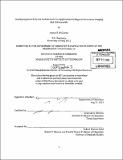Developing novel polymer architectures for applications In magnetic resonance imaging and self-assembly
Author(s)
McCombs, Jessica R. (Jessica Rose)
DownloadFull printable version (4.348Mb)
Other Contributors
Massachusetts Institute of Technology. Department of Chemistry.
Advisor
Jeremiah A. Johnson.
Terms of use
Metadata
Show full item recordAbstract
Macromolecular scaffolds for drug delivery, self-assembly, and imaging applications have attracted significant attention over the last several decades. As polymerization techniques become more sophisticated, it becomes possible to create polymeric architectures with increasing control over structure, molecular weight, and mass dispersity. Herein, ring-opening metathesis polymerization (ROMP) is paired with highly efficient synthetic methods to create functional bottle-brush polymers for MRI imaging and self-assembly applications. In this "graft-through" approach, bivalent macromonomers bearing a terminal exo-norbornene group were synthesized and polymerized to yield bottle-brush polymers with controlled molar masses and low dispersities. This approach is first utilized in the development of organic radical contrast agents (ORCAs) for magnetic resonance imaging (MRI). These ORCAs are composed of macromonomers bearing long polyethylene glycol chains and sterically hindered bis(spirocyclohexyl) nitroxide free radicals. This approach enables facile tuning of nitroxide loading percentages and molecular size. Bottle-brush ORCAs displayed high r₁ and r₂ relaxivities suggesting that they have potential for further in vivo MRI studies. Next, bottle-brush copolymers composed of multiple polymeric domains are synthesized by ROMP. We propose that these multi-block bottle-brush polymers will self-assemble into interesting solution and bulk architectures. Several approaches to synthesizing tetrablock bottle-brush polymers were explored by combining "graft-through" and "graft-from" polymerization methods.
Description
Thesis (S.M.)--Massachusetts Institute of Technology, Dept. of Chemistry, 2013. Cataloged from PDF version of thesis. Includes bibliographical references (pages 48-49).
Date issued
2013Department
Massachusetts Institute of Technology. Department of ChemistryPublisher
Massachusetts Institute of Technology
Keywords
Chemistry.